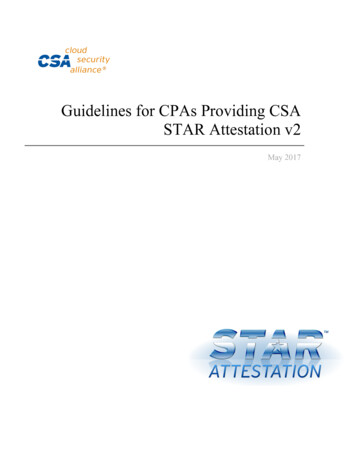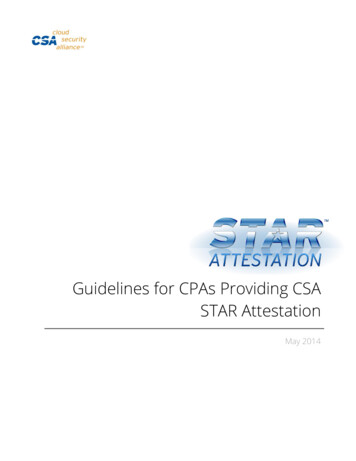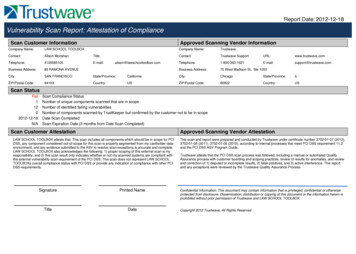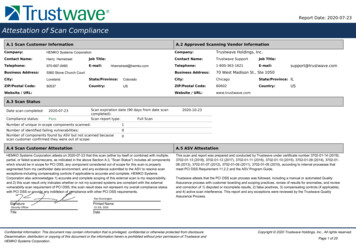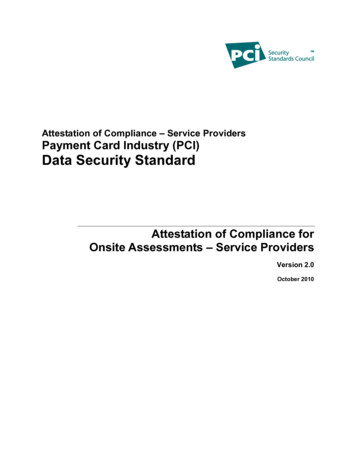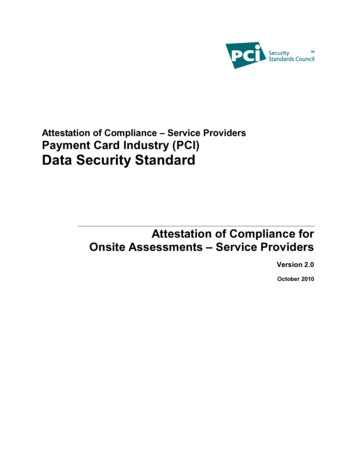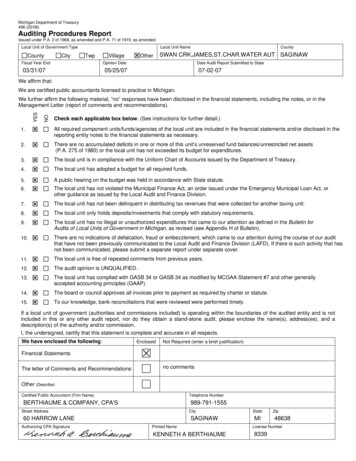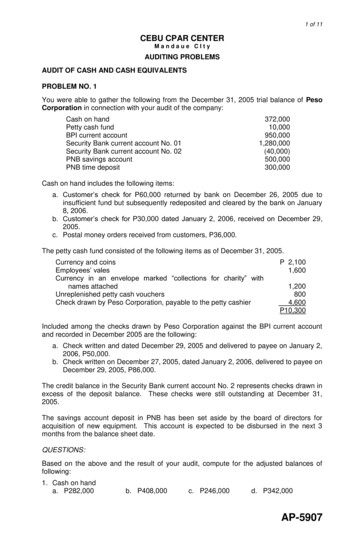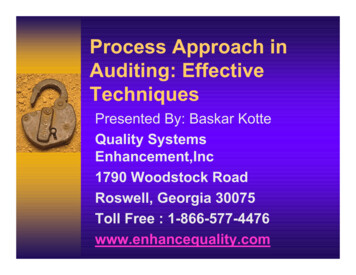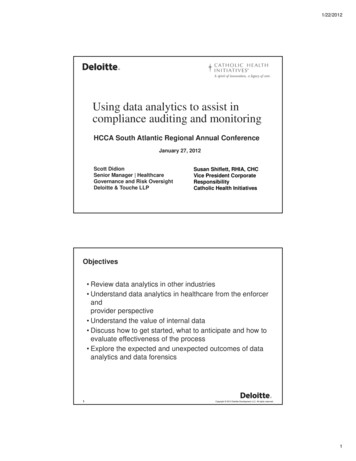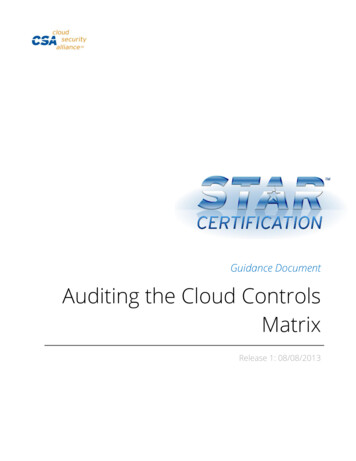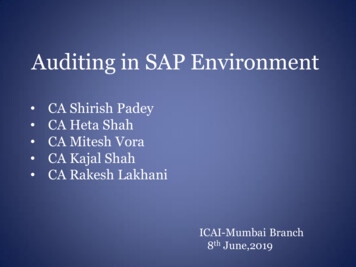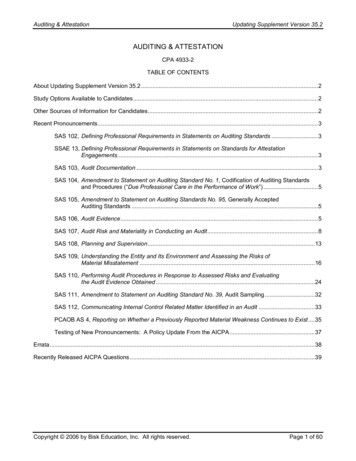
Transcription
Auditing & AttestationUpdating Supplement Version 35.2AUDITING & ATTESTATIONCPA 4933-2TABLE OF CONTENTSAbout Updating Supplement Version 35.2 .2Study Options Available to Candidates.2Other Sources of Information for Candidates.2Recent Pronouncements.3SAS 102, Defining Professional Requirements in Statements on Auditing Standards .3SSAE 13, Defining Professional Requirements in Statements on Standards for AttestationEngagements.3SAS 103, Audit Documentation .3SAS 104, Amendment to Statement on Auditing Standard No. 1, Codification of Auditing Standardsand Procedures (“Due Professional Care in the Performance of Work”) .5SAS 105, Amendment to Statement on Auditing Standards No. 95, Generally AcceptedAuditing Standards .5SAS 106, Audit Evidence.5SAS 107, Audit Risk and Materiality in Conducting an Audit.8SAS 108, Planning and Supervision.13SAS 109, Understanding the Entity and Its Environment and Assessing the Risks ofMaterial Misstatement .16SAS 110, Performing Audit Procedures in Response to Assessed Risks and Evaluatingthe Audit Evidence Obtained .24SAS 111, Amendment to Statement on Auditing Standard No. 39, Audit Sampling .32SAS 112, Communicating Internal Control Related Matter Identified in an Audit .33PCAOB AS 4, Reporting on Whether a Previously Reported Material Weakness Continues to Exist .35Testing of New Pronouncements: A Policy Update From the AICPA.37Errata.38Recently Released AICPA Questions .39Copyright 2006 by Bisk Education, Inc. All rights reserved.Page 1 of 60
Auditing & AttestationUpdating Supplement Version 35.2ABOUT UPDATING SUPPLEMENT VERSION 35.2Information that is only six months old is eligible to be tested on the CPA exam. Supplement version 35.2 isdesigned to bring the very latest information to candidates using our products to prepare for the CPA exam inthe October/November 2006 exam window. Candidates with the 35th edition and corresponding software willfind the information in updating supplement version 35.2 more than adequate for this exam window. All information in the version 35.1 updating supplement is included in the version 35.2 updating supplement.When new information first becomes available, the examiners tend to test new or changed portions of conceptslightly. Coverage of information after that point may increase, if it is in a heavily tested area. Do not fall into thetrap of attaching undue significance to new information merely because it is new.Remember, with the information and techniques in our material, passing the exam is an attainable goal. Adhereto a reasonable study plan—and pass the first time!STUDY OPTIONS AVAILABLE TO CANDIDATESAs every candidate’s needs are different, Bisk Education offers a variety of CPA Review formats and packagesthat are guaranteed* to help you pass the CPA exam on your next sitting. Options include: our Online CPAReview with structured Internet classes and our self-study CPA Review utilizing multimedia CD-ROM software,video lectures, audio lectures, and books.*Purchase of software required. Call for complete details.OTHER SOURCES OF INFORMATION FOR CANDIDATESThe AICPA introduced new content specifications with the computerization of the exam. Candidates with the33rd and earlier editions are strongly encouraged to purchase new materials. Candidates choosing to useprevious editions of our books must accept responsibility for adequately updating their materials. Candidatesshould consider the strain this will add to the already time-consuming process of studying for the exam.Candidates with the 34th edition and corresponding software will also need Updating Supplement Version 34.3.Updating Supplement Version 34.3 contains summaries of SSARS 12, 13, and 14 as well as recently releasedquestions from the AICPA. (This content is integrated into the 35th edition.)Copyright 2006 by Bisk Education, Inc. All rights reserved.Page 2 of 60
Auditing & AttestationUpdating Supplement Version 35.2RECENT PRONOUNCEMENTSIn December 2005, the AICPA’s Auditing Standards Board (ASB) issued SAS 102, Defining ProfessionalRequirements in Statements on Auditing Standards, and SSAE 13, Defining Professional Requirements inStatements on Standards for Attestation Engagements. These statements are effective upon issuance and arefirst eligible for testing in the July/August 2006 exam window.SAS 102, Defining Professional Requirements in Statements on Auditing StandardsSSAE 13, Defining Professional Requirements in Statements on Standards for Attestation EngagementsA.B.Overview: SAS 102 and SSAE 13 define terminology related to two categories of professional requirements that the ASB will use to describe the degrees of responsibility imposed on auditors and practitioners.Even though the terminology was not previously defined, the ASB believes these definitions are consistent with the existing interpretations of the SASs and SSAEs. SAS 102 also amends AU 150, GenerallyAccepted Auditing Standards, by requiring the auditor to document her/his justification for a departurefrom a presumptively mandatory requirement in the work papers.1.Unconditional Requirements: An auditor or practitioner must comply with an unconditional requirement in all cases that the requirement applies. The words must and is required indicate anunconditional requirement.2.Presumptively Mandatory Requirements: An auditor or practitioner must also comply with apresumptively mandatory requirement in all cases in which the requirement applies; however, inrare circumstances the practitioner may depart from the requirement if s/he documents the justification for departure and how other procedures performed were sufficient to achieve the objectives ofthe requirement. The word should indicates a presumptively mandatory requirement.PCAOB Rule 3101, Certain Terms Used in Auditing and Related Professional Practice Standards, presents essentially the same definitions.In December 2005, the AICPA’s ASB issued SAS 103, Audit Documentation. SAS 103 supersedes SAS 96,Audit Documentation and amends SAS 1, Codification of Auditing Standards and Procedures (AU 530, Dating ofthe Independent Auditor’s Report). This statement is effective for periods ending on or after December 15,2006. Early application is permitted. Thus, SAS 103 is first eligible to be tested in the July/August 2006 examwindow.SAS 103, Audit DocumentationA.Overview: Audit documentation serves two main purposes. It provides the principal support for (1) theopinion expressed, or disclaimer of opinion, and (2) the representation in the auditor’s report that the auditwas performed in accordance with U.S. GAAS. Among other things, SAS 103 requires the following.1.Documentation Completion Date: The auditor should complete the final audit file on a timely basis,but within 60 days following the report release date.2.Retention: The auditor should adopt procedures to retain audit documentation for a period sufficient to satisfy legal or regulatory requirements, and to meet practice needs. However, such periodshould be at least 5 years from the report release date. Items that do not need to be retainedinclude: superseded drafts of work papers or financial statements, notes that reflect incomplete orpreliminary thinking, previous copies of documents corrected for errors, and duplicates of documents. After the documentation completion date the auditor must not delete or discard anydocumentation from the final audit file before the end of the specified retention period. Also, theauditor must appropriately document any additions to the audit file after the documentation completion date.Copyright 2006 by Bisk Education, Inc. All rights reserved.Page 3 of 60
Auditing & Attestation3.Updating Supplement Version 35.2Experienced Auditor: Audit documentation should be sufficient to enable an experienced auditor,with no prior connection to the audit, to understand the following:a.The nature, timing, extent, of procedures performed.b.The results of procedures and the evidence obtained.c.The conclusions reached on significant matters.d.That the accounting records reconcile with the financial statements or other informationbeing reported on.4.Oral Explanations: On their own, oral explanations do not constitute sufficient support for the auditwork performed or the conclusions reached. However, they may be used to clarify or explaininformation contained in the audit documentation.5.Significant Findings or Issues: The auditor should document significant findings or issues, actionstaken to address them, and the basis for final conclusions. The auditor should document any discussions, including responses, with management or others within the entity about significant findingsor issues on a timely basis. If the auditor identifies evidence that contradicts or is inconsistent withthe auditor’s final conclusions concerning a significant finding or issue, the auditor should document how the contradictory or inconsistent evidence was addressed in forming the conclusion.B.Audit Report Date: SAS 103 also amends SAS 1 to change the date of the auditor’s report. The auditor’sreport should be dated no earlier than the date on which the auditor has obtained sufficient appropriateaudit evidence to support the opinion. Among other things, sufficient appropriate audit evidence includesevidence that the audit documentation has been reviewed, that the entity’s financial statements, includingdisclosures, have been prepared, and that management has asserted that it has taken responsibility forthem. This will generally result in a report date that is close to the report release date.C.PCAOB Auditing Standard (AS) No. 3, Audit Documentation, presents many of the same requirements asSAS 103 with the exception of the following major differences.1.Documentation Completion Date: The auditor should complete the final audit file within 45 daysfollowing the report release date.2.Retention: Work papers must be retained for 7 years from the report release date.3.Significant Findings or Issues: In addition to SAS 103 requirements pertaining to significant findingor issues, PCAOB AS 3 requires that all significant findings or issues be identified in an engagement completion document. This document may include all information necessary to understandthe significant findings/issues or it may consist of cross-references to the supporting auditdocumentation.4.Work Papers of Other Auditors: All supporting documentation prepared by other auditors must beretained by or accessible to the office issuing the auditor’s report. In addition, the following specificdocumentation must be obtained, reviewed and retained by the office issuing the audit report(unless reference is made to the other auditor):a.An engagement completion document including any cross referenced documentation.b.A list of significant fraud risk factors and results of related audit procedures.c.Sufficient information concerning significant findings/issues that contradict or are inconsistent with final conclusions.d.Any findings affecting the consolidating or combining of accounts in the consolidated financial statements.Copyright 2006 by Bisk Education, Inc. All rights reserved.Page 4 of 60
Auditing & AttestationUpdating Supplement Version 35.2e.Sufficient information to show that financial statement amounts audited by the other auditorreconcile to the information underlying the consolidated financial statements.f.A schedule of audit adjustments including descriptions of the nature and cause of eachmisstatement.g.All significant deficiencies and material weaknesses with a clear distinction between the two.h.Management representation letters.i.All matters to be communicated to the audit committee.In March 2006, the AICPA’s ASB issued eight Statements on Auditing Standards relating to the assessment ofrisk in an audit of financial statements. The AICPA has announced that these standards (SAS 104-111) will notbe tested until the July/August 2007 window. These statements are effective for audits of periods beginning onor after December 15, 2006 with earlier application permitted.SAS 104, Amendment to Statement on Auditing Standard No. 1, Codification of Auditing Standards andProcedures (“Due Professional Care in the Perfor
a. An engagement completion document including any cross referenced documentation. b. A list of significant fraud risk factors and results of related audit procedures. c. Sufficient information concerning significant findings/issues that contradict or are inconsis-tent with final conclusions. d. Any findings affecting the consolidating or combining of accounts in the consolidated finan-
